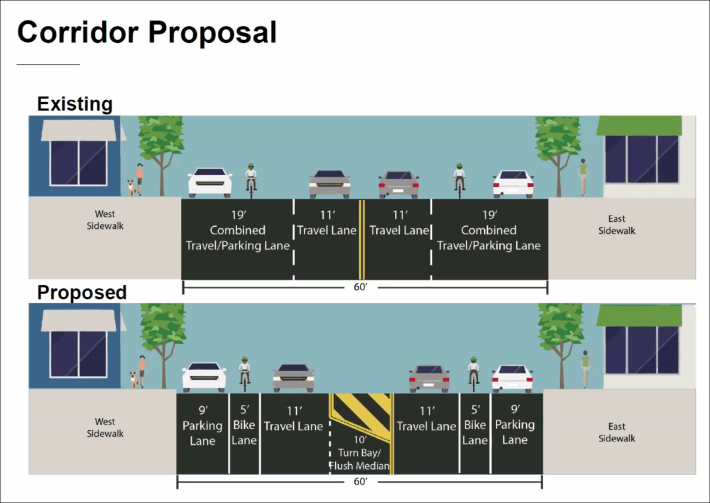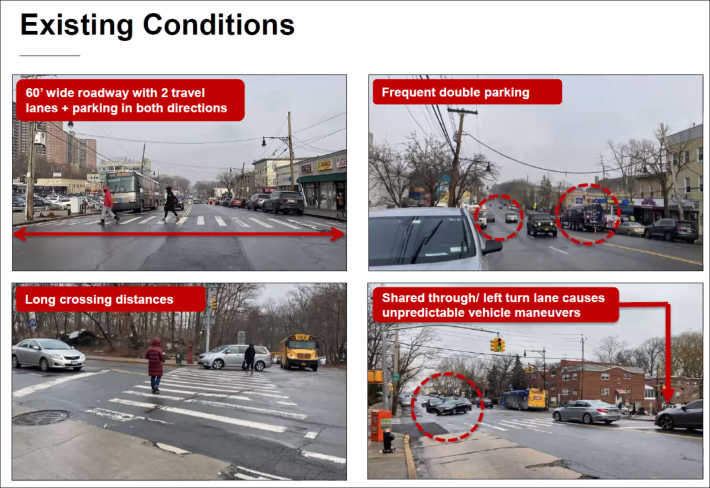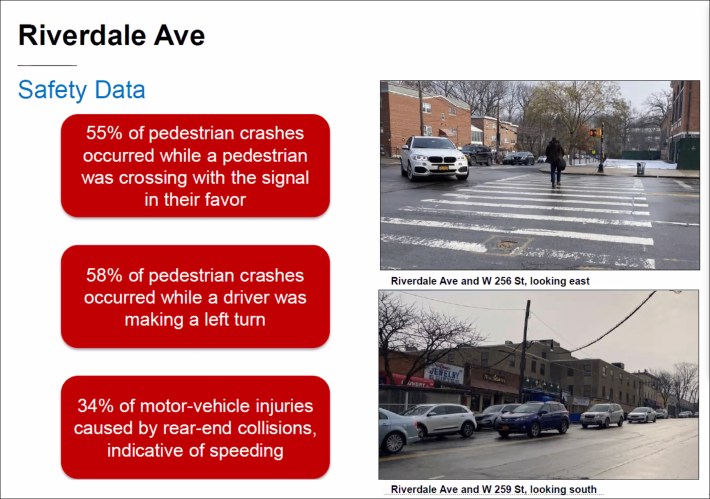Take it back to the drawing board!
A Bronx panel on Thursday night rejected a Department of Transportation plan to slim dangerous Riverdale Avenue by one lane, plus install and other traffic-calming measures, in a contentious 3-2 vote.
The majority on the Traffic and Transportation Committee of Bronx Community Board 8 objected to the DOT's proposed .75-mile-long "road diet," which would provide a treatment similar to the one it successfully installed across the Bronx on Morris Park Avenue. [Here's a PDF of the plan.]
But the citizen panel was merely reflecting the will of many attendees at the online meeting, who spoke vociferously against the proposal, including one comment that forcing drivers to go slower on the speedway-like stretch between W. 254th and W. 263rd streets would cause bottlenecks and was a "disaster in the making!"
"People will die!" said another commenter, claiming he understood traffic solutions better than the DOT's engineers.
The DOT's plan, which is similar to ones that have worked well all over the country as well as in The Bronx, would tame the current 60-foot-wide road by redesigning its 11-foot travel lane and 19-foot combined travel/parking lane into a nine-foot parking lane with a five-foot painted bike lane alongside, then an 11-foot travel lane. It would add a turning bay that would become a median where there are no intersections, from West 254th to West 263rd streets.
See schematic below:

The committee vote, which is only advisory, closely tracked with the recommendations of two area elected officials, Council Member Eric Dinowitz and his father, Assembly Member Jeffrey Dinowitz. Both Dinowitzes have been advocating for years for left-turn signals at two intersections of the six-lane road, which they said was a superior solution than the turning bays proposed by the DOT.
It was a kind of "chicken and egg" argument: A DOT representative at the meeting, Keith Kalb, told the meeting that such signals were not feasible given the road's current configuration, but might be possible once the turning bays are installed ... if the road diet goes forward.

Nothing the DOT said, however, dissuaded the naysayers that the road diet would do anything except slow travel times. Indeed, members of the online audience jeered when the agency presented statistics from three other similar Bronx projects — Burke Avenue, Baychester Avenue, and Morris Park Avenue — that showed reductions in injuries of 47 percent, 22 percent and 37 percent, respectively.
And Morris Park Business Improvement District Executive Director Camelia Tepelus went into the lion's den to debunk another myth that road diets hurt local businesses — an argument that fueled a failed lawsuit against the effort in Morris Park in 2019.
"The redesign has had a positive economic impact," she said, calling it "lifesaving for businesses" during the pandemic.
"Road diets stand the test of time, having been implemented by transportation agencies for more than three decades," according to the Federal Highway Administration's website. "One of the first installations of a road diet was in 1979 in Billings, Montana. Road diets increased in popularity in the 1990s. Cities, including Charlotte, Chicago, New York, Palo Alto, San Francisco and Seattle, have also opted for the positive impact road diets bring to their communities."
The need for traffic calming and better safety is pressing in this surprisingly deadly area of The Bronx. Riverdale Avenue — which begins in Kingsbridge and winds “up the hill” into Riverdale before disappearing under the Henry Hudson Parkway and re-emerging to the north — has experienced notable instances of traffic violence, including spectacular hit-and-run crashes and fatalities, such as one in 2010 that took the life of a 26-year-old. The stretch between West 254th and West 263rd streets runs past P.S. 81 and the Salanter-Akiba-Riverdale High School as well as the Skyview Shopping Center, a hangout for local children with an ice-cream parlor, pizza place and other attractions. The stretch sports several, including a bagel shop, a steakhouse, and a deli. Five MTA bus routes terminate at the city line.
The area also is home to about 6,500 children and 7,000 seniors — and it is the latter who are the biggest victims of traffic violence on the wide avenue. According to the DOT's presentation, two seniors have been mowed down by motorists since 2015, while one motorist died. Sixty-six people were injured during the period, including 26 pedestrians. Most crashes involving pedestrians (55 percent) occurred when pedestrians were crossing with the signal in their favor, and most (58 percent) when motorists were turning left.

"The biggest problems the treatment is addressing is complaints about speeding and crashes," said DOT rep Alicia Posner, who added that the department naturally had "proposed a treatment to reduce speeding and crashes" even as attendees worried only about congestion.
The area's Council District 11, meanwhile, has experienced 14,244 reported crashes in the past five years, which killed 14 motorists and 11 pedestrians and injured 4,533 people, according to city data. That’s an average of almost eight crashes a day — more than its next-door-neighbor District 14 (13,999 in the same period), a much denser urban area that encompasses part of crash-magnet Fordham Road.
The idea of a bike lane was especially unpopular.
"Riverdale Avenue is too busy of a road to have bike lanes," committee member Mary Ellen Gibbs said, as if the lack of a lane somehow could reduce the growing number of cyclists — especially delivery cyclists who use it while working for the area's restaurants. The idea that cyclists might need a safe space to ride did not appear to be considered worthy of discussion. The idea that children could bike to P.S. 81 — a fond hope voiced by committee member David Gellman — was dismissed out of hand.
"There's an accident a month," Gellman said, arguing for "a safe biking route."
His plea did not sway Gibbs. "People on bikes are going to be fair game," she said, insisting that motorists would invade the proposed bike lane (though it should be clear that Gibbs was not advocating for a protected bike lane).
A letter from a bagel-shop owner who worried about "reduced parking" was read aloud by one board member, who proffered it as evidence that local merchants did not support the road diet. Likewise, a missive from the pastor of St. Margaret of Cortona, a church along the route, expressed displeasure that the road diet might impede egress from the parking lot. Kalb assured the group that the DOT's plan was formulated with "the least parking impact to the community" in mind and it was "not necessarily a bike project."
Committee Chair Debra Travis tried gamely to keep the discussion civil but the animus appeared to give pause to the DOT, which said it had planned to start the project in the summer. It would not be the first time that the department balked at the ferocious reaction of CB8: In 2018, it scuttled a plan for a rush-hour bus lane on Broadway after a similar cool reception. The Dinowitzes also opposed that one. Other examples abound: Members of the CB, after approving enhanced crosswalks on a local residential street, Hudson Manor Terrace, backtracked furiously when residents complained they had lost parking.
Said Kalb: "We appreciate your feedback."
It is unclear what will happen next. After the contentious meeting, a DOT spokesman sent over a statement:
Our proposal is still under review. DOT appreciates the feedback from the Bronx Community Board 8 Traffic and Transportation Committee on the proposal for safety improvements on Riverdale Avenue. DOT plans to review the feedback and comments that were received, as well as continue outreach and discussion with community members and stakeholders.






